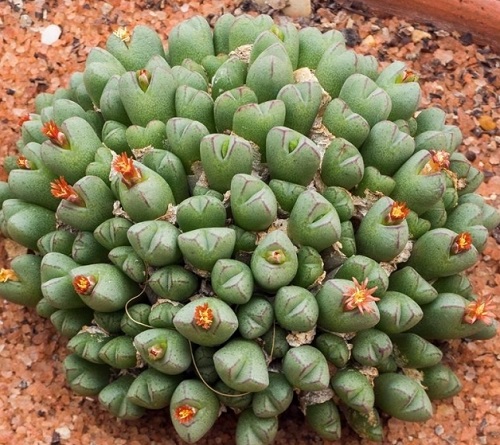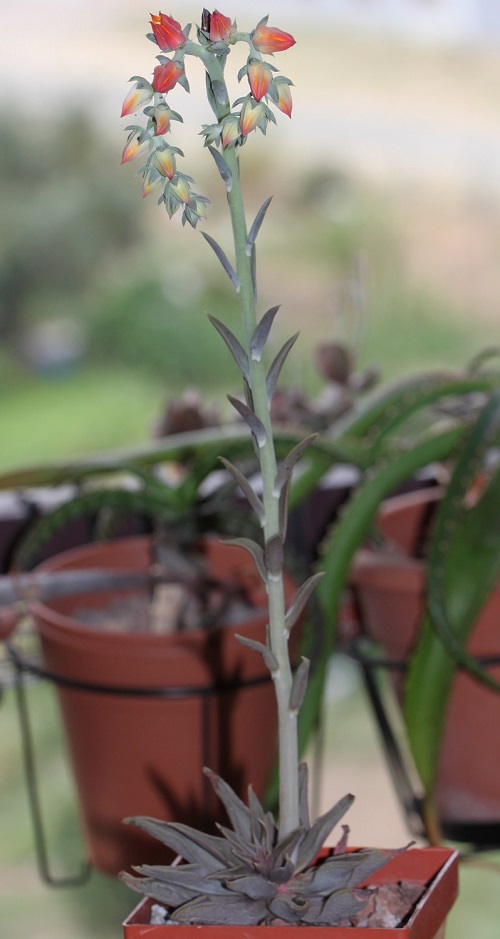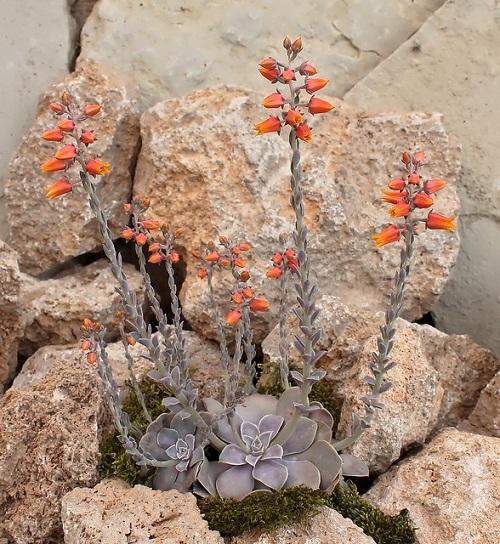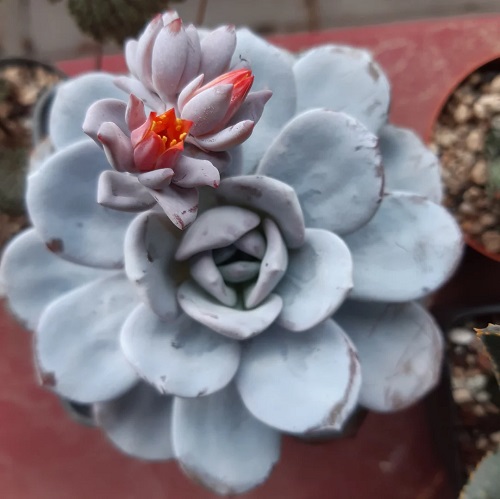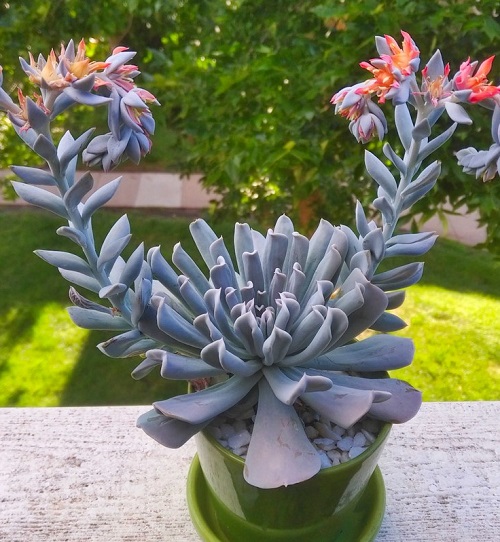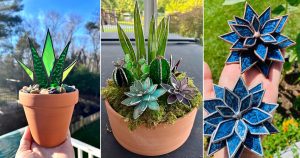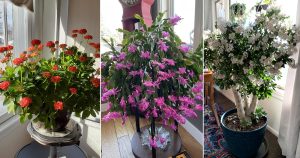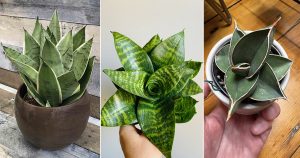Check out this list of gorgeous Succulents With Orange Flowers to beautify your home or garden. Find your new favorite plant today!
Are you fond of the bright hues of orange-flowering succulents? Our extensive list covers some unique varieties that are easy to care for and stunning to look at. Plus, these plants are great for both experienced gardeners and newcomers.
Succulents With Orange Flowers
1. Orange Crown Cactus
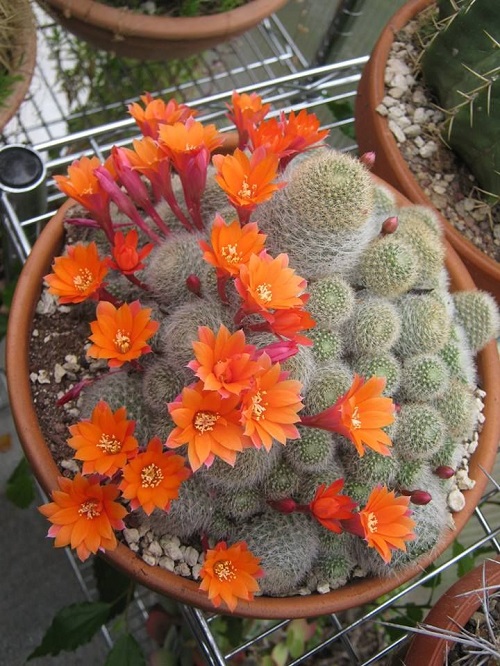
Botanical Name: Rebutia fiebrigii
Orange Crown Cactus is a flowering plant native to the Bolivian Andes. It is highly prized for its ornamental value.
The plant grows in ball shapes covered with silky hairs and tubercles and produces orange daisy-like blooms. You can keep it as a houseplant in full sun exposure and give it moderate watering.
2. Woolly Rose
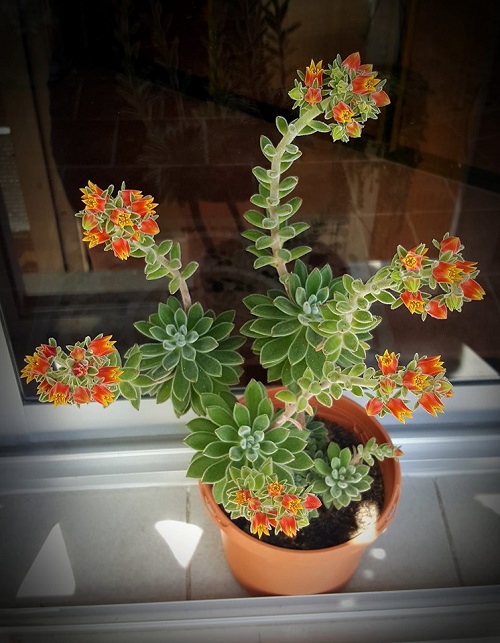
Botanical Name: Echeveria ‘Bombycina’
Woolly Rose features a short-stemmed rosette with pale green leaves covered with white hairs, giving it a soft, woolly texture.
During late summer and early fall, it sprouts small urn-shaped blooms that are a mix of yellow-orange and sometimes yellow-red.
3. Monkey’s Tail
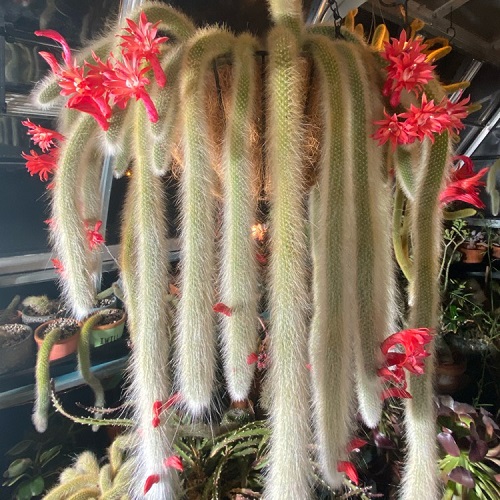
Botanical Name: Cleistocactus winteri
The Monkey’s Tail succulent is a clumping plant with cylindrical stems up to 2 feet or more, covered with golden-yellow spines that become longer and bristly on maturity.
In summer, tubular red-orange flowers, approximately 8 cm in length, emerge on the end of the stems. It thrives in full sun and requires moderate watering with well-draining soil.
4. Orange Flaming Katy
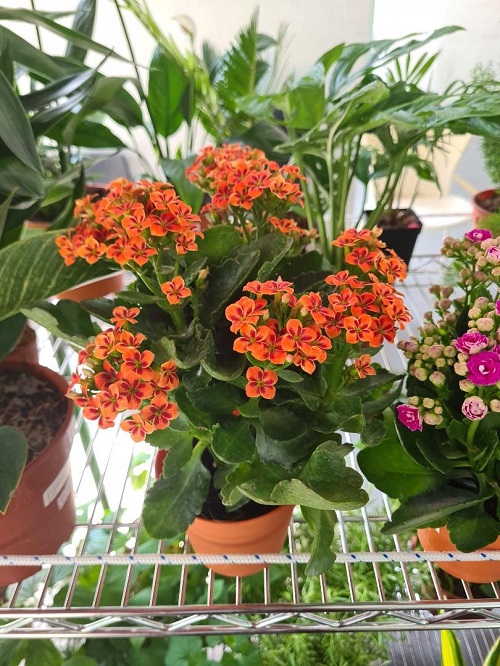
Botanical Name: Kalanchoe blossfeldiana “Orange”
Orange Flaming Katy is popular for its large and robust foliage. Its showy, prolific blooms are bright orange and can brighten your indoor space for many weeks.
The blooms rebloom throughout the year, requiring only bright light and moderate irrigation. In Chinese culture, this plant symbolizes a lucky plant, making it a must-have specimen in your collection.
5. Button Plant
Botanical Name: Conophytum loeschianum
Button Plants are succulents that grow densely in clusters or tufts featuring many stems from one rootstock.
Their bodies are small, 10-12 mm long, with pale green, yellowish-green or sometimes a mix of both. The nocturnal blooms are coppery-orange.
6. Elisa’s Cotyledon
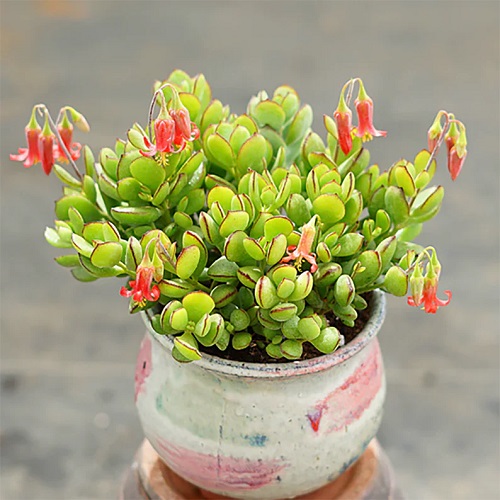
Botanical Name: Cotyledon eliseae
Cotyledon eliseae was introduced by Van Jaarsveld in 1997. Known for its abundant, drooping down blossoms, which gracefully nod atop its green foliage.
In addition, it is a compact plant with sticky leaves that lacks the sprawling habit just like its cousins have!
7. Candelabra Aloe
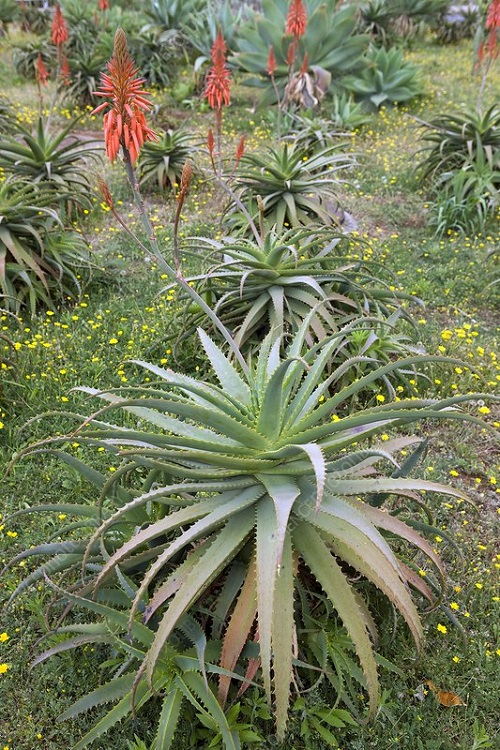
Botanical Name: Aloe arborescens
Candelabra Aloe is loved by gardeners due to its green foliage, winter blooming time, and potential to attract a large number of pollinators.
It belongs to the species of flowering plant whose leaves are arranged on rosettes shaped with small spikes on the edges from which cylindrical-shaped, red-orange color flowers emerge. Candelabra Aloe is also known as epithet arborescens, which means that the plant grows like a tree.
8. Orange Snowball
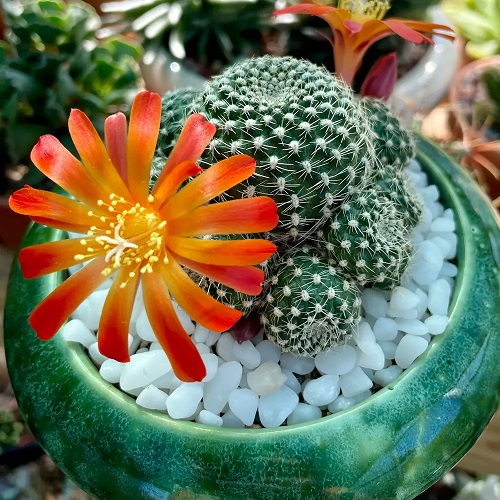
Botanical Name: Rebutia muscula ‘Orange Snowball’
Orange Snowball is a small succulent that grows close to the soil and spreads 4-6 inches in diameter.
Its pale green stems, which are hemispherical when young but later become elongated, cover the landscape vigorously. At the top, they have orange-colored fuzzy flowers.
9. Pig’s Ear
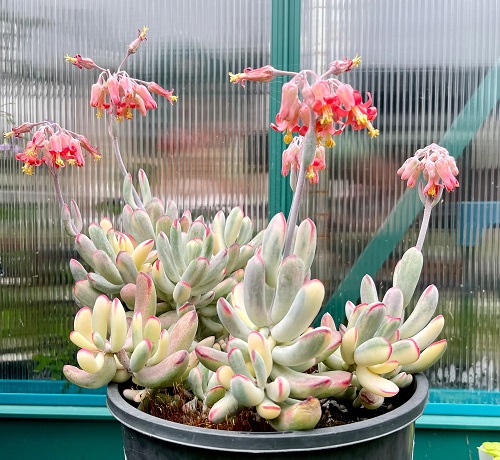
Botanical Name: Cotyledon orbiculata
It’s grey-green leaves develop farina, a powdery substance that naturally helps them reflect sunlight and retain water. Isn’t that a strange trait? In winter, it produces bell-shaped flowers in shades of blood orange-red or paler salmon-orange. Plus, it looks similar to the Kalanchoe plant, so do not get confused!
Pig’s Ear succulent also has many medicinal uses, like South Africans applying its leaves fleshy part on their warts or corns, and its juice has been seen treating epilepsy, earache and toothache.
10. Bear’s Paw
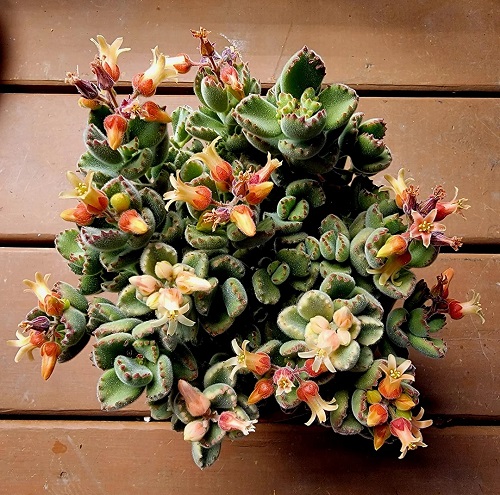
Botanical Name: Cotyledon tomentosa
Bear’s Paw is a perennial succulent from South Africa, particularly found in the little Kargo region. It is known for its fuzzy green leaves, which look similar to bear paws because of their distinctive teeth-like edges.
In spring, large orange bell-shaped blooms emerge from the plant, making it a sought-after addition to any garden. This plant needs excellent drainage and porous soil to maintain its shrub-like look!
11. Red Echeveria
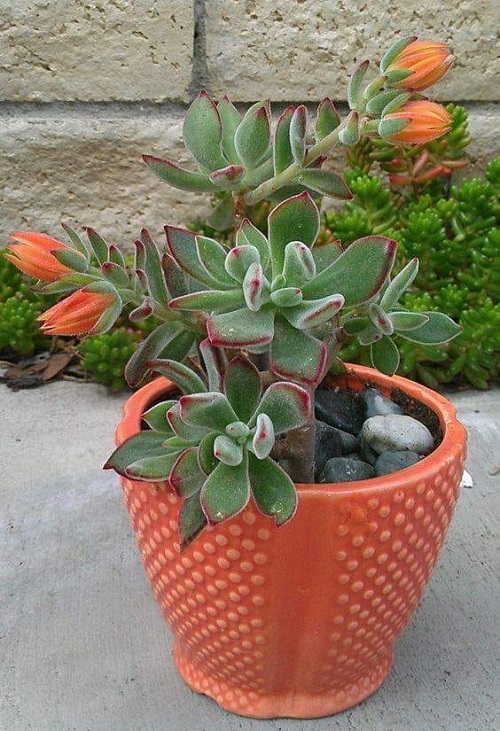
Botanical Name: Echeveria harmsii
Red Echeveria is a plant with hairy, fleshy, thick green leaves and red tips that form clusters of rosettes, which is an attractive hub for hummingbirds. People grow it for the love of its beautiful, bell-shaped reddish-orange color blooms and gets small, lush colonies in late spring and summer in return.
You can keep this plant indoors, but keep it in bright, indirect light with well-draining soil and moderate watering.
12. Bitter Aloe
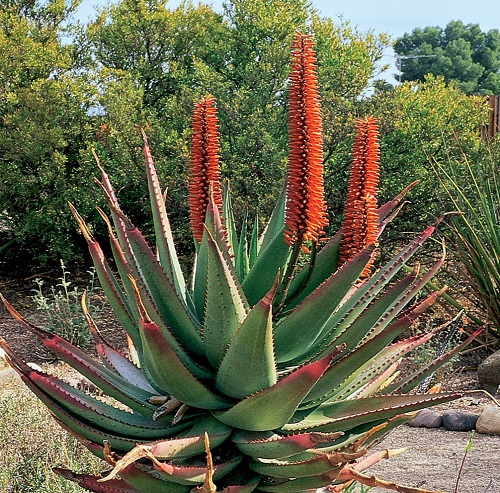
Botanical Name: Aloe ferox
Bitter Aloe is a woody flowering plant native to southern Africa. It is a single-stemmed plant with reddish-brown spines and clusters of orange or red flowers. Suitable for outdoor cultivation due to its love of full sun and moderate watering.
Widely grown for commercial purposes because of its usefulness in putative medications and cosmetics.
13. Mountain Aloe
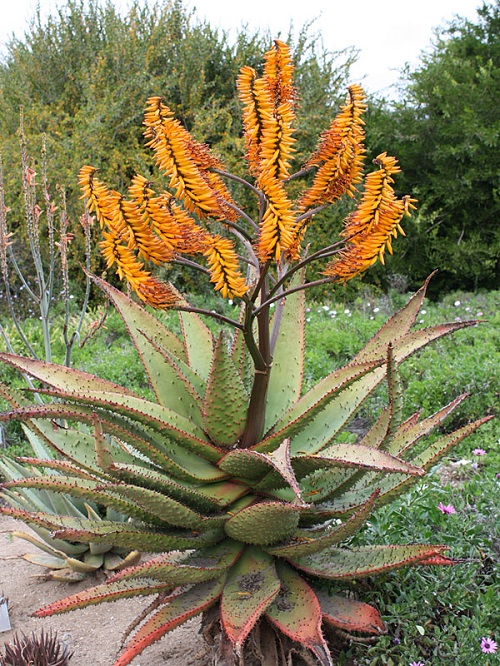
Botanical Name: Aloe marlothii
This is another aloe vera variety that is particularly found in rocky places or open, flat countries. In addition, it is capable of attracting nectar-feeding birds and bees.
Mountain Aloe is a large evergreen succulent that can grow up to 6 feet, and it’s bloom changes color from yellow to orange to bright red, brightening up your landscape with its majestic presence. It prefers full sun and moderate watering when the soil is dry.
14. Shrubby Conophytum
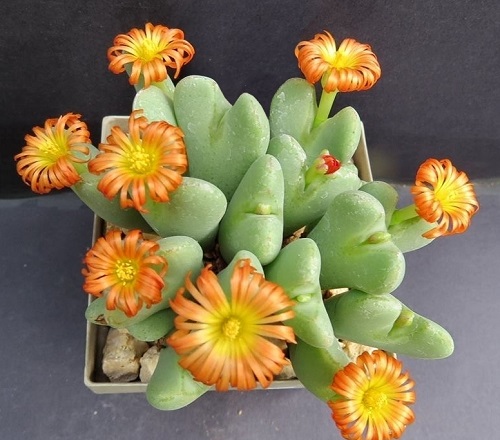
Botanical Name: Conophytum frutescens
Mainly found growing in succulent karoo along with other lush vegetation like Massonia depressa and Eriospermum aphyllum.
Shrubby Conophytum is a slow-growing succulent with loose spherical bodies. Its coloration varies from yellow-green to turquoise, often with purple streaks or patches. Additionally, you will see big, beautiful blooms ranging in color from orange to coppery or pinkish on the top of the foliage.
15. Orange Ice Plant
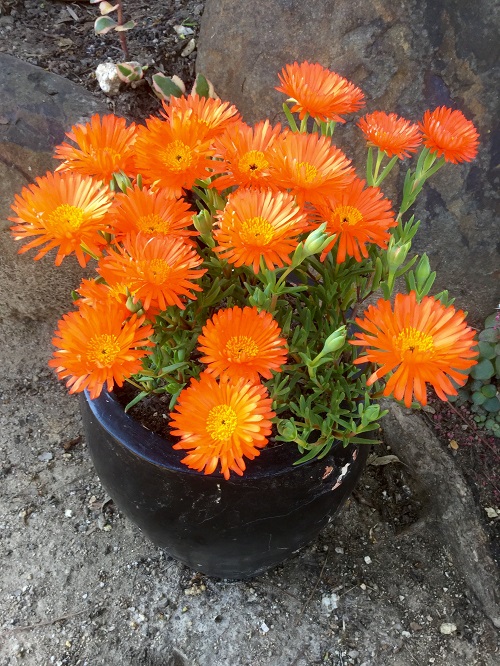
Botanical Name: Lampranthus aurantiacus
Orange Ice Plant is a subshrub native to South Africa that can grow up to around 14 inches in height and spread up to 5 feet, covering your area with its long grey-green leaves.
From late spring to summer, it produces eye-catching bright oranges with yellow center flowers. Plus, this succulent with orange flowers can easily survive in your landscape with full sun and dry soil. You can use it as a filler around low plantings or on slopes.
16. Silver Crown
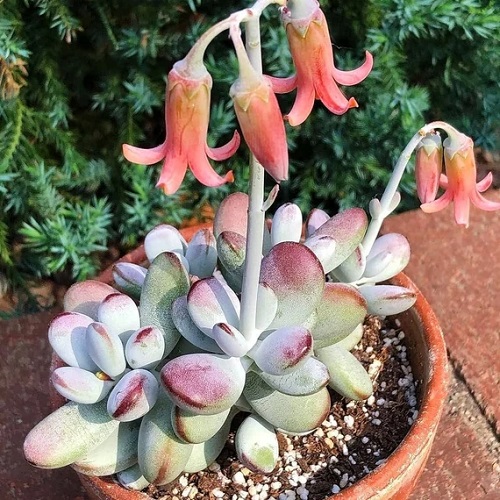
Botanical Name: Cacaliopsis nardosmia
Silver Crown is commonly known as Silver Ruffles. This compact succulent is popular among gardeners due to its white-coated stems and scallop shell-like leaves, which range from grey-white to blue-grey and have wavy edges. It produces orange to yellow flowers in spring and summer seasons.
17. Cliff Cotyledon
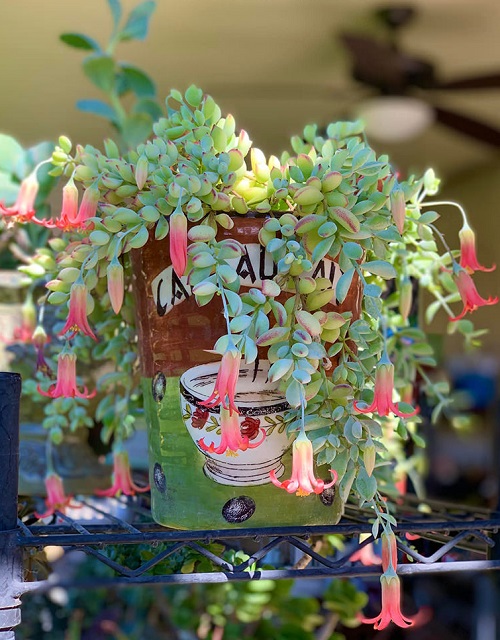
Botanical Name: Cotyledon pendens
Cliff Cotyledon is a rare succulent, particularly found along the Mbashe River in the Eastern Cape. It has multiple green stems that grow downwards and thick, fleshy leaves that form a curtain-like appearance, making it a great addition to hanging baskets, rockeries, and terraces.
During summer, it produces clusters of bell-shaped flowers from the end of the branches.
18. Airplane Plant
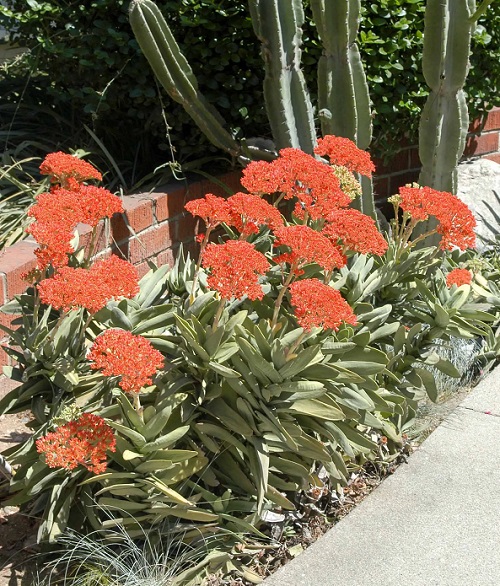
Botanical Name: Crassula perfoliata var. falcata
It is a plant with pairs of sickle-shaped leaves that grow one above the other, meaning overlapping each other. Airplane Plant lacks branches but produces tiny scarlet-red flowers with a hint of orange in clusters, which led this plant to earn its other common name—Scarlet Paintbrush.
19. Bifida
Botanical Name: Echeveria bifida
When viewed from afar, this plant’s fully developed leaves resemble real diamonds growing in a pot. Echeveria Bifida is a picture-perfect plant with greyish-brown rosettes that carry slender flower stalks topped with salmon-pinkish orange blooms.
In addition, it is a compact specimen that contains up to 20-25 leaves and is approximately 15-20 cm wide. If you have just started your succulent collection, then this is the best one to start with.
20. Shattering Echeveria
Botanical Name: Echeveria diffractens
Due to its flattened rosettes, this succulent looks like a 3D plant. Its spoon-shaped leaves are tinged with a pinkish-grey hue. From summer to spring, it produces abundant flowering stalks, giving rise to orange, bell-like flowers with yellow tips.
21. Laui
Botanical Name: Echeveria laui
Echeveria laui’s beauty lies not only in its blooms but also in its graceful foliage. It has a delicate, short-stemmed rosette in pristine white or occasionally pinkish, complemented with glaucous leaves. However, once these leaves die, they can attract pests like mealybugs.
In such scenarios, careful maintenance is key. Provide ample water but not still/standing within the plant’s container and plenty of sunlight to make it flourish in your garden.
22. White Cloud Plant
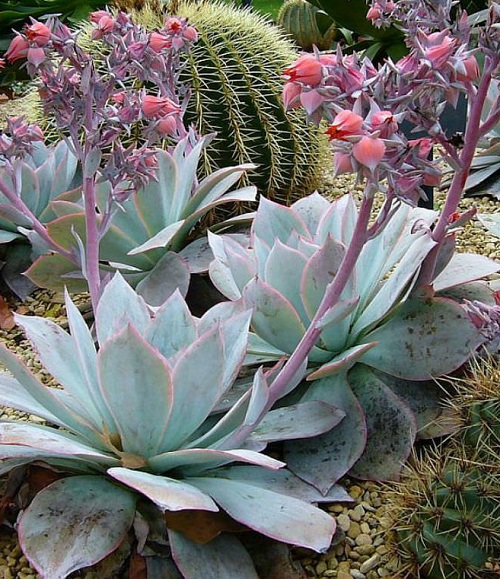
Botanical Name: Echeveria cante
Expect this succulent to grab your attention at first sight with its huge, solitary rosettes, which have reddish-pink margins and are covered with farinose—a white, mealy powder. You can see many leaves in a single specimen and clusters of pruinose orange-pink blooms.
So, if you are planting them in a garden, then maintaining the distance between each entity serves as a prominent marker for exploration.
23. Peanut Cactus
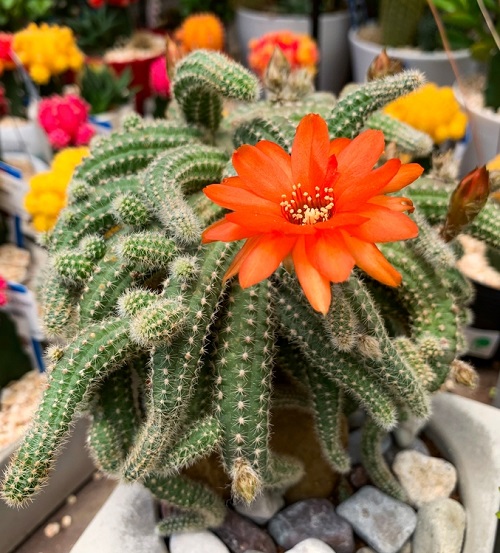
Botanical Name: Echinopsis chamaecereus
Peanut Cactus holds a special place in botanical history. Why? Because its natural habitat and ecological niche remain a mystery. Botanist Carlo Spegazzini collected it at the beginning of the 20th century.
From an early age, the cactus has abundant orange-red blooms, growing on crowded finger-like stems that start off as pale green, erect bodily structures, gradually aging into woody and spineless. Additionally, it can easily be displayed in hanging baskets or pots, offered with well-drained soil and sunlight.
24. Topsy Turvy
Botanical Name: Echeveria runyonii ‘Topsy Turvy’
Topsy Turvy has the characteristics of being untidy and open in shape due to its narrow leaves. Ranging from blue-green to silver-grey, twisting inwards, giving the appearance of being turned inside out—unable to form a rosette. This is a common trait shared by other species within the same genus.
Come late summer, it displays bright orange, pink, or apricot flowers borne on arching racemes.

